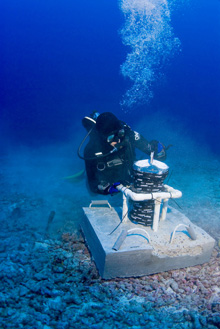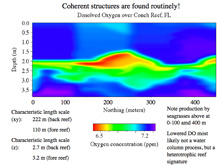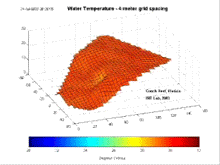
Figure 1. A diver deploying a bottom-mounted acoustic doppler current Profiler (ADCP). These devices use sound waves to measure flow speed throughout the water column. As the sound hits particles in the water moving with the current, the particles shift the frequency of the return echoes (the Doppler effect). The shift in frequency increases with flow speed, so we can measure the water movements over the reefs of Bonaire at a multitude of heights. This is necessary to differentiate between the effects of waves passing overhead, and tidal currents running along the bottom. The hydrodynamics of reefs is not well known. Click image for larger view and image credit.
The Importance of Physical Oceanography to Coral Reef Science
Jim Leichter
Associate Professor
Scripps Institution of Oceanography
University of California at San Diego
Dale Stokes
Associate Research Oceanographer
Scripps Institution of Oceanography
Coral reefs are often thought of as "ecological oxymorons." They harbor some of the greatest biodiversity on Earth, yet they develop in extremely nutrient-poor tropical waters. Reef-building corals represent ancient lineages that have evolved slowly over tens to hundreds of millions of years, yet the massive living reef structures we observe right now are geologically young features, often only a few thousand years old. And, the massive, robust calcified corals that build the reef framework are themselves quite fragile and sensitive to a host of natural and manmade disturbances and degradation.
The animals and plants that build and live on coral reefs have developed extraordinary means of gathering energy and resources from their physical environment, and many of these adaptations involve complex biological interactions with a broad range of symbioses. Also, the physical environment of coral reefs is characterized by tremendous variation and patchiness in both space and time. A calm and protected back reef habitat may sit just a hundred meters or less from the crashing surf zone, and a quiet, cloudless morning can give way to a howling gale and torrential rains by midday. One of our goals as oceanographers and coral reef ecologists is to study this environmental variation and patchiness to help us better understand the fundamental nature of coral reefs and to contribute knowledge useful for preserving these complex but delicate ecosystems.
Observing and trying to understand the changing physical environments on coral reefs is somewhat analogous to studying the weather on land. Like meteorologists, oceanographers depend heavily on technology for our fundamental measurements and observations — on small, waterproof, digital recording sensors that can be deployed in the ocean for months at a time to measure currents, temperature, salinity, light availability, nutrient concentrations, water chemistry and other properties.
As part of the Bonaire project, a team of scientists from the Scripps Institution of Oceanography will deploy an array of current meters and temperature recorders measuring conditions at multiple sites around the island (Figure 1). Their work in other reef settings, most notably in the Florida Keys, U.S., and Moorea, French Polynesia, has shown the highly variable and dynamic nature of physical conditions that can exist on coral reefs. Large scale ocean currents and the seasonal changes in temperature and solar exposure provide the background conditions for a given reef, and forms what we might think of as the seasonal oceanographic climate. In addition to the large scale "underwater climate" there are a number of oceanographic physical phenomena that vary on time scales of weeks to days, hours, and even minutes, and we think of these in the context of the ‘underwater weather’ on a reef. Recently, the Fetch1 autonomous underwater vehicle (AUV) made the discovery that dissolved oxygen on a reef can be very variable (Figure 2).

Figure 2. Map of dissolved oxygen made by the Fetch1 autonomous underwater vehicle (AUV) performing a "yo-yo" maneuver over a coral reef in Florida. Large packets of lower oxygen water, called "coherent structures" because they persist for many minutes to hours, were found over these reefs. We are interested in seeing whether this is a sign of reef degradation. We are predicting we won’t find these lowered-oxygen water masses in Bonaire, but we won’t know until we measure the physical and chemical environment. Click image for larger view and image credit.

Figure 3. Animation of data acquired by the Scripps BOA array, a network of temperature sensors logged by a computer. This animation shows an internal wave traveling up the slope of a coral reef in Florida. This wave brings colder, nutrient rich water up onto the reef. Red colors indicate warmer water and blue is cold water, ranging from about 20º to 30º C (68º to 86º F). The vertical axis of the animation is depth and the horizontal axes reflect the area covered by BOA. This is a remarkable change in temperature recorded over a matter of hours and minutes on the reef. You can see that sometimes water moves up the spurs and grooves of the reef face, or gets caught in pockets. It will be interesting to see whether there are internal waves around Bonaire’s reefs. Click image for larger view and image credit.
A dramatic example of underwater weather occurs on the Florida Keys reef tract where surges of cool water are repeatedly pushed onto the reef slopes by breaking internal waves. Internal waves can be broadly defined as gravity waves occurring within density-stratified fluids and are common in both the coastal and open oceans. Internal waves can be much larger than surface waves — with wave heights of tens of meters to as much as 100 meters (328 feet) — and they travel much more slowly than surface waves. When internal waves run into shallow water they can steepen and break just like surf (Figure 3). The interactions of internal waves with the complex topography of a reef can dramatically affect water temperatures, near-bottom turbulence and mixing, the distribution of dissolved nutrients, and the vertical and horizontal transport of sediments and plankton.
The sensors that we will be deploying around Bonaire will help us understand the complex physical environment and how that influences the coral reef ecosystem. Knowing how important physical properties like temperature, currents and nutrients are transported and vary around the reefs will provide information to help ecologists manage and preserve the Bonaire Marine Park.


























